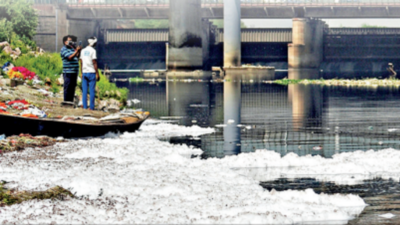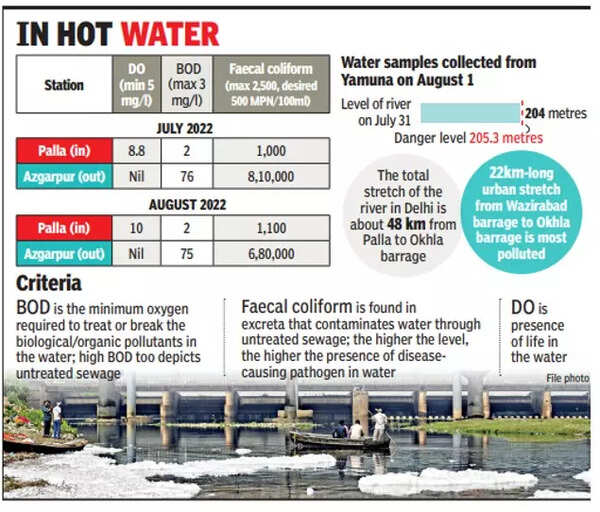Top Searches
- News
- City News
- delhi News
- ...No cheer on river front, Yamuna in Delhi dirtier despite better flow of water
...No cheer on river front, Yamuna in Delhi dirtier despite better flow of water

The report shows only a marginal improvement in the faecal coliform level, which was 270 times the maximum permissible limit by the time the river exited the city.
NEW DELHI: The pollution in the Yamuna’s water soared in August despite an increase in its volume and a better flow to clean the river, according to Delhi Pollution Control Committee’s quality assessment report.
The report shows only a marginal improvement in the faecal coliform level, which was 270 times the maximum permissible limit by the time the river exited the city.

The dissolved oxygen (DO) status of the river at the exit point was determined to be nil and the biochemical oxygen demand (BOD) 75 mg/l, which is 25 times the safe limit.
The level of the Yamuna began rising on July 30 with the release of water from the Hathni Kund dam in Haryana. For much of the time, the water level was measured at 204 metres, around a metre below the danger mark. It was expected that with more water flowing in the Yamuna, the river quality would improve. However, the additional flow from Haryana couldn’t make much difference to the state of the river.
According to the experts, while it takes a few days for the fresh flow to clean a river, the high pollution level in the river can be attributed to the additional pollutants flowing in from Haryana. “It takes some time for the river to clean up so when the excess water is released upstream. There is a lot of pollution left and the additional flow takes some time to clean the river entirely,” explained environmentalist Manoj Mishra. “However, it could also be the case that the water being released upstream from Haryana was polluted too because a large volume of effluent is discharged in that state.”
In July, the flow in the Yamuna was nominal, contributing to the high pollution level. According to the report that month, the faecal coliform level in the river on entering Delhi was 1,000 MPN/100ml and by the time it approached the end, reaching Asgarpur, the confluence of the Shahdara and Tughlaqabad drains, the figure was an abysmal 8,10,000 MPN/100ml — 324 times higher than the maximum permissible limit of 2500 MPN/100ml and 1,620 times higher than the desired limit of 500 MPN/100ml. According to experts, faecal coliform is found in excreta flowing into the river with untreated sewage. The higher the coliform level, the greater the presence of disease-causing pathogens in the water.
In August, the faecal coliform at the entry was 1100 MPN/100ml, rising to 6,80,000 MPN/100ml, lower than in July, by the time the river exited the city despite the diluting effect of more water. DO at the exit point was 0 and BOD was 75 mg/l, or 25 times the safe standard.
The report shows only a marginal improvement in the faecal coliform level, which was 270 times the maximum permissible limit by the time the river exited the city.

The dissolved oxygen (DO) status of the river at the exit point was determined to be nil and the biochemical oxygen demand (BOD) 75 mg/l, which is 25 times the safe limit.
The level of the Yamuna began rising on July 30 with the release of water from the Hathni Kund dam in Haryana. For much of the time, the water level was measured at 204 metres, around a metre below the danger mark. It was expected that with more water flowing in the Yamuna, the river quality would improve. However, the additional flow from Haryana couldn’t make much difference to the state of the river.
According to the experts, while it takes a few days for the fresh flow to clean a river, the high pollution level in the river can be attributed to the additional pollutants flowing in from Haryana. “It takes some time for the river to clean up so when the excess water is released upstream. There is a lot of pollution left and the additional flow takes some time to clean the river entirely,” explained environmentalist Manoj Mishra. “However, it could also be the case that the water being released upstream from Haryana was polluted too because a large volume of effluent is discharged in that state.”
In July, the flow in the Yamuna was nominal, contributing to the high pollution level. According to the report that month, the faecal coliform level in the river on entering Delhi was 1,000 MPN/100ml and by the time it approached the end, reaching Asgarpur, the confluence of the Shahdara and Tughlaqabad drains, the figure was an abysmal 8,10,000 MPN/100ml — 324 times higher than the maximum permissible limit of 2500 MPN/100ml and 1,620 times higher than the desired limit of 500 MPN/100ml. According to experts, faecal coliform is found in excreta flowing into the river with untreated sewage. The higher the coliform level, the greater the presence of disease-causing pathogens in the water.
In August, the faecal coliform at the entry was 1100 MPN/100ml, rising to 6,80,000 MPN/100ml, lower than in July, by the time the river exited the city despite the diluting effect of more water. DO at the exit point was 0 and BOD was 75 mg/l, or 25 times the safe standard.
FOLLOW US ON SOCIAL MEDIA
FacebookTwitterInstagramKOO APPYOUTUBE
Start a Conversation
end of article









